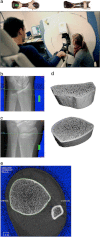High-resolution peripheral quantitative computed tomography for the assessment of bone strength and structure: a review by the Canadian Bone Strength Working Group
- PMID: 23525967
- PMCID: PMC3641288
- DOI: 10.1007/s11914-013-0140-9
High-resolution peripheral quantitative computed tomography for the assessment of bone strength and structure: a review by the Canadian Bone Strength Working Group
Abstract
Bone structure is an integral determinant of bone strength. The availability of high resolution peripheral quantitative computed tomography (HR-pQCT) has made it possible to measure three-dimensional bone microarchitecture and volumetric bone mineral density in vivo, with accuracy previously unachievable and with relatively low-dose radiation. Recent studies using this novel imaging tool have increased our understanding of age-related changes and sex differences in bone microarchitecture, as well as the effect of different pharmacological therapies. One advantage of this novel tool is the use of finite element analysis modelling to non-invasively estimate bone strength and predict fractures using reconstructed three-dimensional images. In this paper, we describe the strengths and limitations of HR-pQCT and review the clinical studies using this tool.
Figures


References
Publication types
MeSH terms
Grants and funding
LinkOut - more resources
Full Text Sources
Other Literature Sources
Medical

